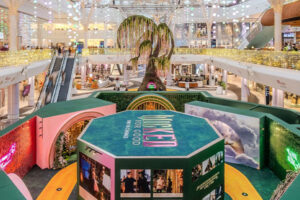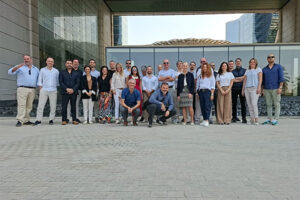By Gianfranco Lizzul
If we analyze shopping centers built in past decades, we can see the incredible similarities among the schemes built in all corners of the world. That is not surprising, given the fact that the original idea of contemporary suburban shopping centers sprang up in the USA after the Second World War, and that successful model was simply replicated, with timid adjustments to satisfy local conditions. In order to better understand how the new generation of shopping center developments may look in the very near future, it is helpful to take a historical look back at and analyze the evolution of this building type in order to find some useful answers to questions regarding the development of future landmarks.
The earliest examples of shopping areas were created during ancient Roman times, when shopping markets were located in forums. Later, similar concepts were developed in the Middle East in the form of bazaars, which were the predecessors of today’s shopping malls. European examples began to develop in market towns, where retail was an important part of the economy and definitely shaped the urbanism of future cities. Some of these shopping centers are the oldest continuously occupied malls in the world and are still in use today (Chester Rows in England and Marche des Enfants Rouges in France). Next, the era of grand city arcades, which are still in use today, followed in major European cities in the 19th century.
The invention of the motorized car and its proliferation in the 20th century drove developers to suburbs outside of city centers, where cheap land could be found, thereby enabling the development of enclosed and inward-facing malls, with convenient parking areas to satisfy motorized customers. This trend was particularly popular in the USA for two main reasons: lack of consolidated historical city centers and motorized car culture. This model was then exported to Europe and further east to Asia, where the largest shopping malls are still being built today.
Since history often repeats itself, we will soon see a return to models similar to the ones that weathered the “tooth of time” well and endured through the centuries – obviously adapted to contemporary trends. Do not get me wrong, the world will always move forward, but lessons from the past could be used to solve present-day problems. Today, everyone in the retail industry wonders what is coming next. We desperately need new concepts in order for retail to evolve and progress this century. Technology is developing so quickly in all fields, not only IT, and the built environment, traditionally lagging, has to respond adequately. Customers will always shop and use city centers for all sorts of activities typical to urban living, and the civic buildings, shops, restaurants, and leisure establishments must respond to new trends and be designed in such a way to adapt more quickly to those needs than any time before in history.
It is interesting to see that some very old buildings are still in use today, perfectly serving the functions for which they were built. Moreover, these are easily adapted, if necessary, for today’s functions, which are different to the original purposes. Most contemporary architecture is not like that, and, at least for architects, that is a challenge to be tackled.
New era consumer habits are continuously changing. The use of technology in commerce has contributed to decreasing volumes of traditional sales within shops. On the other hand, online shopping has increased substantially, with the effect that traditional shop owners and mall developers will have to adapt sooner rather than later to this ever-increasing trend.
Future retail will become a compromise of traditional and online shopping. The two shopping methods should be complementary in order to satisfy everyone’s needs. This will inevitably change the design of future shopping centers and force leasing agents to carefully rethink retail mixes. There is no doubt that certain goods, such as clothing, shoes, and fashion, will generally still be purchased in the “traditional” way. Customers will always prefer to see, touch, and smell the product before buying it, and such a shopping method allows them to have products there and then. Online purchasing of many other goods may have advantages; however, products will never be available immediately.
Inevitably, online retailers will mitigate the lag in delivery as much as they can, which will result in the complete rethinking of storage systems and logistics in order to move goods as quickly as possible. For architects, this retail revolution will create new design challenges and opportunities to develop the next generation of retail projects. Rather than building new shopping “cathedrals” in suburbs and “decorating” them with leisure, entertainment, and eatery themes that offer fake “life experiences”, the way forward should be to use “good old” city centers as natural anchors for next-generation retail schemes, where all the elements of genuine urban living and life experiences already exist. This is why the previously mentioned history of towns, markets, and retail is extremely important with regard to the design and creation of new-generation, sustainable, and successful retail schemes. Scale, flexibility, and quick adaptability will prove to be the winning elements of future retail schemes.
Regarding scale, inevitably smaller schemes, due to the downsizing of the retail areas needed to trade, should be expected since the majority of goods will be available online from the same stores. Some increase in storage areas is a reasonable expectation. Flexibility, which is an extremely important element, will allow the retail and leisure mix to be changed and adapted as and when necessary. With regard to adaptability, the design of prototype retail models that can be easily adapted and “plugged” to a variety of urban situations or existing attractions, without the need for substantial site works is also to be expected.
There are countries within Europe as well as the wider world where the above approach could be easily implemented, but, unfortunately, this approach could prove more challenging in a substantial number of countries due to complicated administrative and political systems. The paradox is that countries with a substantial number of historic centers that could be enhanced and used as “anchors” to a new generation of retail schemes, adding significant value to the cities, are the most complicated concerning the approval of urban renewals. If our forbearers had had a similar approach of constructing and demolishing buildings throughout the centuries, our heritage today in the built environment would be very bad, if not bleak. We would not have Rome, Florence, Venice, Paris, London, or any of the other wonderful and successful trading cities across Europe.
The architectural profession, tasked with designing commercial projects of all types, will have to work closely with a new generation of enthusiastic investors and clients and will have to be keen to develop and deliver the next generation of retail and other schemes in order to catch up with fast-changing consumer behavior.
Sign up for our ACROSS Newsletter. Subscribe to ACROSS Magazine.





